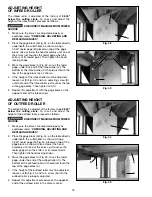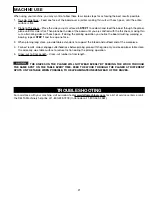
22
MAINTENANCE
Fig. 53
Fig. 54
A
B
Fig. 55
E
C
D
Fig. 56
F
LUBRICATION
The gear box oil should be changed once a year. Use
extreme pressure gear oil, available from Delta in one
pint cans (you will need approximately 20 oz.). The gear
box drain plug is shown at (A) Fig. 53. The oil fill and
level plug is shown at (B) Fig. 54.
The four raising screws, two of which are shown at (C)
Fig. 55, should be lubricated as required using a
common grease.
Periodically remove screw (D) Fig. 55, and side cover (E).
Thoroughly clean chains and sprockets (F) Fig. 56, and
lubricate using a light (10W) machine oil. Replace side
cover (E) Fig. 55, and secure with screw (D).
Periodically squirt light (10W) machine oil on the feed
roller bushings (G) Fig. 57, two of which are shown, at
each end of the feed rollers.
KEEP MACHINE CLEAN
Periodically blow out all air passages with dry compressed
air. All plastic parts should be cleaned with a soft damp
cloth. NEVER use solvents to clean plastic parts. They could
possibly dissolve or otherwise damage the material.
Wear ANSI Z87.1 safety glasses while
using compressed air.
FAILURE TO START
Should your machine fail to start, check to make sure the
prongs on the cord plug are making good contact in the
outlet. Also, check for blown fuses or open circuit breakers
in the line.
PROTECTING CAST IRON FROM
RUST
To clean and protect cast iron tables from rust, you will
need the following materials: 1 pushblock from a jointer,
1 sheet of medium Scotch-Brite™ Blending Hand Pad, 1
can of WD-40
®
, 1 can of degreaser, 1 can of TopCote
®
Aerosol. Apply the WD-40 and polish the table surface
with the Scotch-Brite pad using the pushblock as a
holddown. Degrease the table, then apply the TopCote
®
accordingly.
Fig. 57
G
CLEANING INFEED AND OUTFEED
ROLLERS
The infeed and outfeed rollers (H) Fig. 57, will need to be
cleaned periodically. Use soap and water and scrub the
infeed and outfeed rollers with a scotch brite pad.
H



































